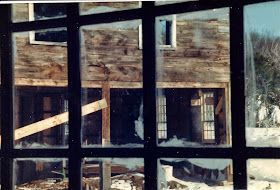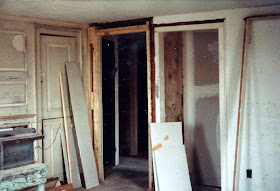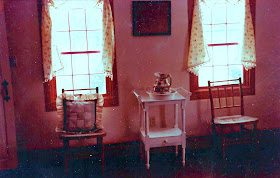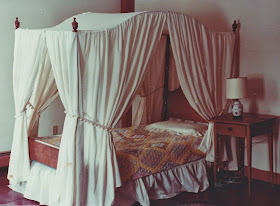THE
OLD HOUSE
AT
IPSWICH VILLAGE

SAVING MOSES JEWETT’S HOUSE
POST ROAD DEVELOPMENT CORPORATION
1981-1982
PART 10
PRUDENCE PAINE FISH
SALVAGING OLD FURNITURE
While all the work and
other details were being tended to at the house and in the office, Nancy was
hard at work on the old Waycott furniture. The pieces most interesting were
probably left from Mrs. Waycott’s parents, the Eilenbergers, who had lived there before the Waycotts and the Orcutts.
Most of it was dismal but
some of it salable with Nancy’s help.
The best was in the attic and consisted of Larkin chairs and
bureaus. You know, that oak furniture
that was earned by saving Larkin soap wrappers? What was thrown away not too many years ago was now in vogue. Press backed chairs could be sold and were sold.
 |
| Typical of chairs found in the attic. |
In the lean-to was the
bottom of an old oak sideboard. It was
filthy. Oil had spilled on it. Old tools were in the drawers and remnants of
linens that had been attacked by mice. It did
seem as though it might have possibilities with work. Suddenly I remembered something under the
eaves in the attic. It was the etegere
top for the sideboard with what-not shelves and beveled mirror soaring for
several feet above the sideboard base.
It was a big job to clean and refinish it. When it was back to its original condition
we took it to Bob’s shop and he put it in the show window with a a spotlight on
it. It was gone in a day! I can’t remember the price but it may have
been $800.
 |
| Very similar to the oak sideboard found in lean-to and attic. This was found on eBay. |
Another gem was a pine
cupboard. That went equally fast for
similar money. There was also a cottage chest or two, part of late 19th century paint decorated bedroom set.
The remainder of the things were so unremarkable that today I can’t even recall them but little by little it was all sold. Actually they were typical of what one might expect to find in an old run-down farmhouse.
The remainder of the things were so unremarkable that today I can’t even recall them but little by little it was all sold. Actually they were typical of what one might expect to find in an old run-down farmhouse.
 |
| Similar to pine cupboard found in house and sold. This example is from the Internet. |
Two large sterling serving spoons
had and “E” on the handle, probably for Eilenberger. The pattern was Towle Canterbury from the
1890s. I gave these beautiful spoons to the new owners.
SUBDIVISION
Distasteful as it was, we
had to think about our ace in the hole.
We could subdivide and sell off two lots. But first we were a little short of the
necessary frontage. Our lawyer confided
to us that our neighbors, the Barneys, needed to replace their septic system
and it might be just the right time to negotiate the purchase of a few feet
from them to make the subdivision work.
We let our lawyer, George Hayes do the negotiating. The deal was accepted and completed.
Now we could offer the
whole package for $180,000 or the house alone for $150,000. I prayed for a buyer to come along who would
want the whole thing. I didn’t want to
be a party to subdividing. Spring turned
to summer and summer to fall. We were
more nervous than you can imagine. We
couldn’t give it back to the bank nor could we continue to struggle under the weight of this construction loan with the highest interest rates ever.
One day a Realtor from our
office, Dottie, said cheerfully, “Pru, I have good news for you. I have an offer for one of the lots.” My heart sank. This would bail us out but I had been holding
my breath that we wouldn’t have to do this.
But do it, we did. We had no
choice. The contract was signed.
In just a few days another Realtor
from the office, Sandra, took two buyers from New York out to look at
property. She took them all over
Rockport and Gloucester. Late in the day
they returned to the office. They had
not found anything they wanted. They
were introduced and I chatted with them.
They were selling a business in Manhatten and wanted to move to New
England.
My brain clicked into gear.
Here were two people escaping New York
City for a taste of New England. What
was more New England than our Moses Jewett house sitting there waiting? What
could fit the bill more than our picture-perfect Currier and Ives farmhouse in
the country? “Sandra”, I said. “Didn’t you show them the Moses Jewett
house?” “No.” she replied. “I didn’t
even think of it.” She didn’t think of
it? Our own office listing! And she had dragged them all over Cape Ann
for nothing. I had trouble containing myself and bit my tongue.
I proceeded to tell them
about the house, got them excited, gave them the listing material, gave Sandra
the key and told her to get them up there on the double. They went and just as I fantasized, they
loved it. In fact, they were infatuated
with the history, the restoration and everything about it. And, better still, they bought it!
More heartbreak when they
told us they would like all of the land, all six acres. There was nothing we could do. It was under agreement to Dottie’s customers
and the die was cast. The last of the Jewett farm of 100 acres was now
subdivided into approximately two acre parcels.
BUYERS AT LAST
On November 17th
the lot on the street east of the house was sold to the Fowlers who would build
a house on the site. The closing on the Jewett house was set for December 1, 1982.
 |
| The house the Fowlers built next door later expanded and improved by neighbors Ron and Gwen. |
At this point David decided
he would buy the lot in the rear that would be up a long driveway. His plan was to build a Maine Post and Beam
saltbox for himself, Shelley and his boys, Zachary and Spencer. He would sell his house in Newbury but would
need a place to live while building.
 |
| Maine Post and Beam house built by David at the end of the long driveway. He called the address 1 Post Road just for fun.. |
It turned out that Hugh and
Jerry, our buyers, would not be ready to move until the following summer so an
agreement was reached whereby David and family would live in the Moses Jewett house
until their house was complete.
There would be no mortgage
or bank involved in the sale so the closing could take place right there in the
house. Hugh and Jerry arrived from New York and we all
gathered around a big table in the old kitchen in front of the fireplace. We had wine.
A toast was in order. David
conducted the closing and tallied up the assorted checks to make up the total
selling price. After the closing David
drove the new buyers to the Registry of Deeds in Salem and the deed was
recorded.
 |
| The back page of the deed. The deed was done...literally! The house that had been part of out lives for so long was now theirs. |
Was that the end of the
story? Not at all! A new chapter was beginning.
Work progressed on David’s new house with its long drive. He affectionately called his new house the house at “One Post Road” after the name of our group, Post Road Development Corporation, and the historic reference to the old highway called the Post Road. I guess you could call it a private joke.
Work progressed on David’s new house with its long drive. He affectionately called his new house the house at “One Post Road” after the name of our group, Post Road Development Corporation, and the historic reference to the old highway called the Post Road. I guess you could call it a private joke.
It was the summer of 1983
when Hugh and Jerry arrived with a truck and moved into the Moses Jewett
house. David was in his new house. The Fowlers had a built a new cape next door. So many lot of changes since that September day
when we purchased the old place nearly two years prior. Following the Fowler a friendly couple, Ron and Gwen took up residence and became good friends and neighbors to Hugh and Jerry.
For their first Christmas, 1983,
Hugh and Jerry had a party. All of their
guests were Realtors from the Vernon A. Martin office. The only people they had met were Realtors
but by now everyone in the office knew them.
What a house for a party.
Candles, fires in the fireplaces, great food and drink were in abundance. This was the first of many. A pattern
emerged. There was a Christmas party
each December, usually on a Sunday evening, and another in the late summer on
the newly built bluestone patio outside the two back doors. The numbers grew, people came and went, the
cast of characters changed but the routine remains to this day. No one who has ever crossed that threshold at
Christmas can forget the ambiance, the fires, warm friendships and good times.
David and Shelley moved
on. Their house was sold. The land was further subdivided. So imagine my surprise when driving past the old
place one day a few years ago to see a new street sign on what had previously been David’s driveway. And what did they name
this new street? Post Road Lane! I was
incredulous. The inside joke from twenty years before had become a reality and
now numerous families make their home on Post Road Lane.
Nearly thirty years later,
Hugh and Jerry, our buyers, are still happily in the house. The neighbors and friends keep coming. It has been a good quarter century plus for
the old Moses Jewett house
 |
| The Moses Jewett house in the snow. Not the true red but very pretty anyway!
One more installment before moving on. Hang in there!
|










.jpeg)
















